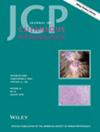Clinical, Serologic, and Histopathologic Features of Patients With Pemphigus With Either Positive or Negative IgG4 Intercellular Deposition by Direct Immunofluorescence (DIF): A Retrospective Case–Control Study of 55 DIF Biopsy Specimens
Abstract
Background
Intercellular IgG4 deposition is variably present on DIF in patients with pemphigus. Whether this feature has clinical, serologic, or histopathologic correlates was unknown.
Methods
We identified 34 patients with pemphigus who had 55 DIF specimens reported to show intercellular IgG, IgG4, and/or C3 deposition (8/22/2017–11/30/2023). Patients and biopsies were stratified by intercellular IgG4 status. Clinical and serologic data were extracted from electronic records, and corresponding biopsy slides were reviewed for histopathologic findings.
Results
Among the 34 patients with pemphigus, patients with positive IgG4 were significantly more likely to have detectable serum anti-desmoglein 1/3 antibodies by ELISA (p = 0.014 and p = 0.030, respectively). Paraneoplastic pemphigus (PNP) was more frequent in the IgG4-negative group (p = 0.037), particularly among patients with ocular involvement. Of 55 DIF biopsy specimens meeting inclusion criteria, 52 (94.5%) had intercellular IgG deposition and 42 (76.4%) had intercellular IgG4 on DIF. Compared to IgG4-negative specimens, IgG4-positive specimens were significantly more likely to represent a vesiculobullous lesion (p = 0.024), to be derived from the trunk (p = 0.047), to show histologic acantholysis (p = 0.019) and to lack lichenoid inflammation (p = 0.0004).
Conclusion
For pemphigus, DIF IgG4 status correlated with ocular involvement, the clinical morphology selected for biopsy, the likelihood of detecting circulating desmoglein antibodies, the presence of specific histopathologic features such as acantholysis and lichenoid inflammation, and the likelihood of having a final diagnosis of PNP. Further studies are needed to determine whether the presence of tissue-bound intercellular IgG4 antibodies correlates with particular disease variants or lesion-specific characteristics.

 求助内容:
求助内容: 应助结果提醒方式:
应助结果提醒方式:


